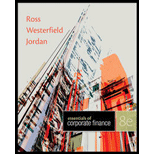
a)
To determine: The share price after a 5-3 stock split.
Introduction:
A company divides its share into multiple shares and issues them to the shareholders as an additional share; as per the decisions by the management, it is termed as a stock split.
a)
Answer to Problem 6QP
The share price is $56.4.
Explanation of Solution
Given information: BT Company has 420,000 shares of stock outstanding and sells at $94 per share with a stock split of 5-3.
The formula to calculate the share price:
Compute the new share price:
Hence, the new share price is $56.4.
b)
To determine: The share price at 15% stock dividend.
Introduction:
Stock dividend: The distribution of dividends in the form of additional shares is termed as stock dividend. It is also termed as ‘Scrip dividend’.
b)
Answer to Problem 6QP
The share price after a 15% stock dividend is $81.74.
Explanation of Solution
Given information:
BT Company has 420,000 shares of stock outstanding and sells at $94 per share with stock dividend of 15%.
The formula to calculate the share price:
Compute new the share price:
Hence, the new share price is $81.74.
c)
To determine: The share price at 42.5% stock dividend.
Stock dividend: The distribution of dividends in the form of additional shares is termed as a stock dividend. It is also termed as ‘Scrip dividend’.
c)
Answer to Problem 6QP
The share price after 42.5% stock dividend is $65.96.
Explanation of Solution
The formula to calculate the share price:
Compute the new share price:
Hence, the new share price is $65.96.
d)
To determine: The share price after a 4-7 reverse stock split.
Introduction:
Reverse stock split is where the company reduces its shares, which are outstanding. It is the opposite of forward stock splits. This works normally as a regular dividend but reverse action will take place.
d)
Answer to Problem 6QP
The share price is $164.5.
Explanation of Solution
Given information: BT Company has 420,000 shares of stock outstanding and sells at $94 per share, and declared reverse stock split of 4-7.
The formula to calculate the new share price:
Compute the new share price:
Hence, the new share price is $164.5.
e).a)
To determine: The new number of shares outstanding.
e).a)
Answer to Problem 6QP
The new number of shares outstanding is 700,000.
Explanation of Solution
Given information:
BT Company has 420,000 shares of stock outstanding and sells at $94 per share.
The formula to calculate the new number of outstanding shares:
Compute the new outstanding ratio:
Hence, the new numbers of outstanding shares are 700,000.
b)
To determine: The new number of shares outstanding
b)
Answer to Problem 6QP
The new number of shares outstanding is 483,000.
Explanation of Solution
The formula to calculate the new outstanding shares:
Compute the new number of shares outstanding:
Hence, the new numbers of outstanding shares are 483,000.
c)
To determine: The new number of shares outstanding
c)
Answer to Problem 6QP
The new number of shares outstanding is 598,500.
Explanation of Solution
The formula to calculate the new number of outstanding shares:
Compute the new number of shares outstanding:
Hence, the new number of outstanding shares is 598,500.
d)
To determine: The new number of shares outstanding
d)
Answer to Problem 6QP
The new number of shares outstanding is 240,000.
Explanation of Solution
The formula to calculate the new number of outstanding shares:
Compute the new outstanding ratio:
Hence, the new number of outstanding shares is 240,000.
Want to see more full solutions like this?
Chapter 14 Solutions
Essentials of Corporate Finance
 Essentials Of InvestmentsFinanceISBN:9781260013924Author:Bodie, Zvi, Kane, Alex, MARCUS, Alan J.Publisher:Mcgraw-hill Education,
Essentials Of InvestmentsFinanceISBN:9781260013924Author:Bodie, Zvi, Kane, Alex, MARCUS, Alan J.Publisher:Mcgraw-hill Education,

 Foundations Of FinanceFinanceISBN:9780134897264Author:KEOWN, Arthur J., Martin, John D., PETTY, J. WilliamPublisher:Pearson,
Foundations Of FinanceFinanceISBN:9780134897264Author:KEOWN, Arthur J., Martin, John D., PETTY, J. WilliamPublisher:Pearson, Fundamentals of Financial Management (MindTap Cou...FinanceISBN:9781337395250Author:Eugene F. Brigham, Joel F. HoustonPublisher:Cengage Learning
Fundamentals of Financial Management (MindTap Cou...FinanceISBN:9781337395250Author:Eugene F. Brigham, Joel F. HoustonPublisher:Cengage Learning Corporate Finance (The Mcgraw-hill/Irwin Series i...FinanceISBN:9780077861759Author:Stephen A. Ross Franco Modigliani Professor of Financial Economics Professor, Randolph W Westerfield Robert R. Dockson Deans Chair in Bus. Admin., Jeffrey Jaffe, Bradford D Jordan ProfessorPublisher:McGraw-Hill Education
Corporate Finance (The Mcgraw-hill/Irwin Series i...FinanceISBN:9780077861759Author:Stephen A. Ross Franco Modigliani Professor of Financial Economics Professor, Randolph W Westerfield Robert R. Dockson Deans Chair in Bus. Admin., Jeffrey Jaffe, Bradford D Jordan ProfessorPublisher:McGraw-Hill Education





